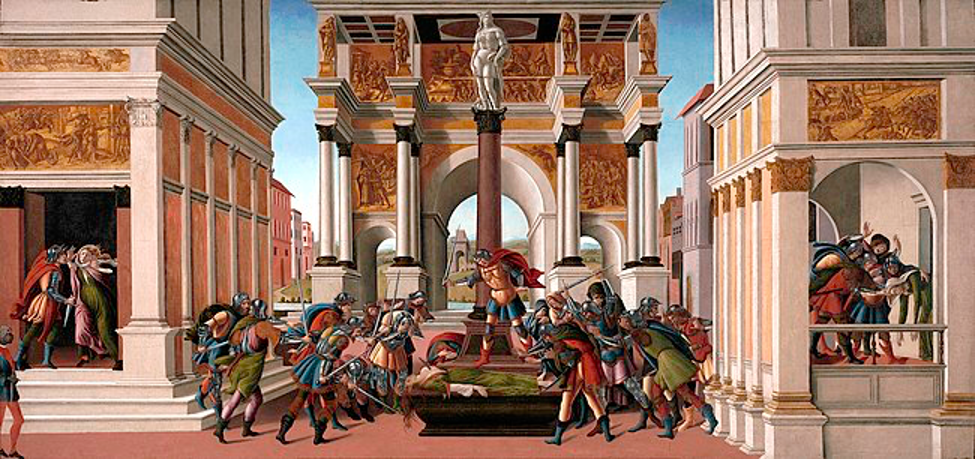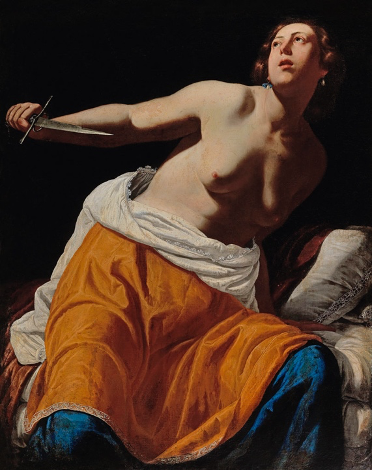Martyr to Muse: The Power of Perspective in Livy’s Lucretia Story
In Livy’s The Stories of Rome, the name Lucretia is synonymous with the end of the Roman monarchy. Raped by Prince Tarquinius, Lucretia’s tragic fate represented the growing resentment towards the monarchy among the Roman people. Answering Lucretia’s call for retribution, witnesses of her suicide avenged her death by triggering a revolt against their monarchical tyrants. Lucretia’s blood, “the purest in Rome till Tarquinius polluted it,” represented the corruption of Rome by the monarchy (Livy 31). Her rape and suicide are credited by Livy’s tale with establishment of the Roman Republic.
Lucretia’s story is immortalized in many reproductions by some of art’s big names like Rembrandt, Botticelli, and Veronese. Shakespeare and Chaucer even got in on the action, each with their own narrations of Lucretia’s story. The importance of contrasting multiple works to expose differing perspectives on a topic is revealed when comparing two such reproductions of Livy’s tale.
Botticelli’s Bastardization?

Botticelli’s interpretation, “The Story of Lucretia” is unique when viewed among other interpretations in that it depicts Lucretia’s story from start to finish on the central plane of the piece, as if the observer was reading a line from Livy’s text.
Botticelli, known for his dramatic paintings of heroines like “The Birth of Venus,” “Primavera,” and “Madonna and Child” where women are the focus, strays from his usual, iconic compositional style in this painting. Lucretia is physically small compared to the colossal architecture and hoards of figures and is portrayed as demure and helpless, always pictured surrounded by men, attacker and avenger alike. Even the statue of David is more prominent and draws the eye more than Lucretia herself in this piece.
While it is a faithful interpretation of Livy’s words, Botticelli doesn’t choose to refocus Livy’s Lucretia story on her heroism, as other reproductions will do. Botticelli’s choice to focus on a political reading of Lucretia’s narrative is even more peculiar in that it strays from his own precedent.
With a modern critical eye, Botticelli’s minimization of Lucretia, the namesake of the story he is supposedly telling, to the side panels, and the overall grandeur of the rest of the piece raises a question in Botticelli’s interpretation: are Lucretia’s rape and suicide being romanticized or even forgotten in this retelling?
Gentileschi Gives it a Go

Artemisia Gentileschi’s depiction of this very same, poignant moment in Rome’s history, “Lucretia,” is told from a vastly different perspective. Gentileschi, in her own right, was and is seen as a feminist icon, a figure similar to Lucretia in Livy’s story. She was an extremely accomplished artist in a professional career otherwise unattainable for women in her time. Further, she was a victim of sexual violence who prosecuted her attacker in court, enduring torture herself to prove her attacker’s guilt. Her personal experience with rape, known publicly even then, attributes legitimacy to her depiction of a fellow victim: Lucretia.
Lucretia, illuminated by a heavenly light, contrasts harshly with the background, making her the focal point. The black background and general lack of context makes this piece ahistorical and thus more autobiographical in nature. Naked, her hair done, and wearing earrings, Lucretia’s sex is much more explicit than her depiction in Botticelli’s painting, thrusting the issue of rape into the limelight. Rather than minimizing her to solely a catalyst for political change, Gentileschi’s depiction highlights Lucretia as the main character in her story, taking control of her destiny in her suicide.
No “Right” Interpretation
In comparing these two works, the danger of a one-sided story becomes clear. If an observer was armed with no background information on Livy’s tale, they would be hard-pressed to relate these two depictions. It is challenging to identify the “legendary heroine” for which Rome owes regime overthrow as the same figure in these two depictions. While artistic liberty is expected, the biases in retelling must be revealed by examining multiple perspectives. We can only appreciate and recognize artistic liberty when we can recognize it compared to the original work.
Gentileschi herself has painted Lucretia three times, Rembrandt, twice. It is essential to see Lucretia as more than a heroic martyr, merely the latest self-sacrifice in the road to the democratization of Rome. She must at least also be considered as a tragic victim. This is what Gentileschi’s piece lends us: the opportunity to see something different than what is directly dictated by the text.
This demonstrates the importance of having students write text afterlives in the first place. It forces critical thinking, and as Shane Knopp argues, afterlives like paintings (or in his case a Laconian Cup), engage the original text and provoke conversation; the afterlife “becomes part of the [ongoing] legacy” of the original work. In Livy’s case, the examination of Lucretia’s afterlives allows for readers to focus on both the political ramifications outlined in Botticelli’s work, remaining faithful to Livy’s words, and widen the scope of the conversation to Lucretia’s tragic rape by examining Gentileschi’s.
In juxtaposing different afterlives of the same original text, we reject canonical, monolithic interpretations of cornerstone texts in our society that may persist otherwise.
SOPHIA FRIGULETTO is a member of Colgate’s class of 2024 from Dallas, Texas. She intends to major in Economics but also harbors a passion for art and art history.